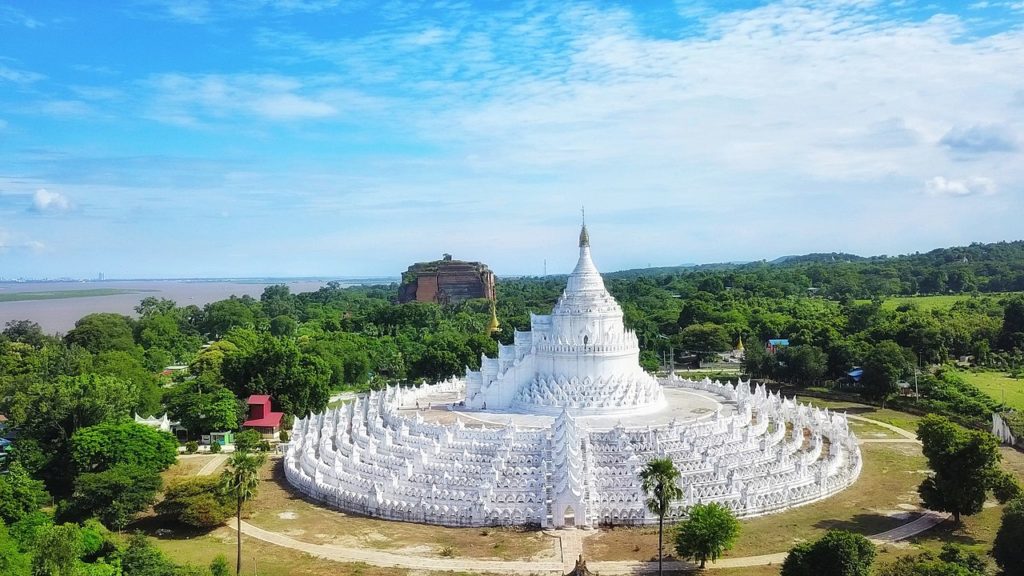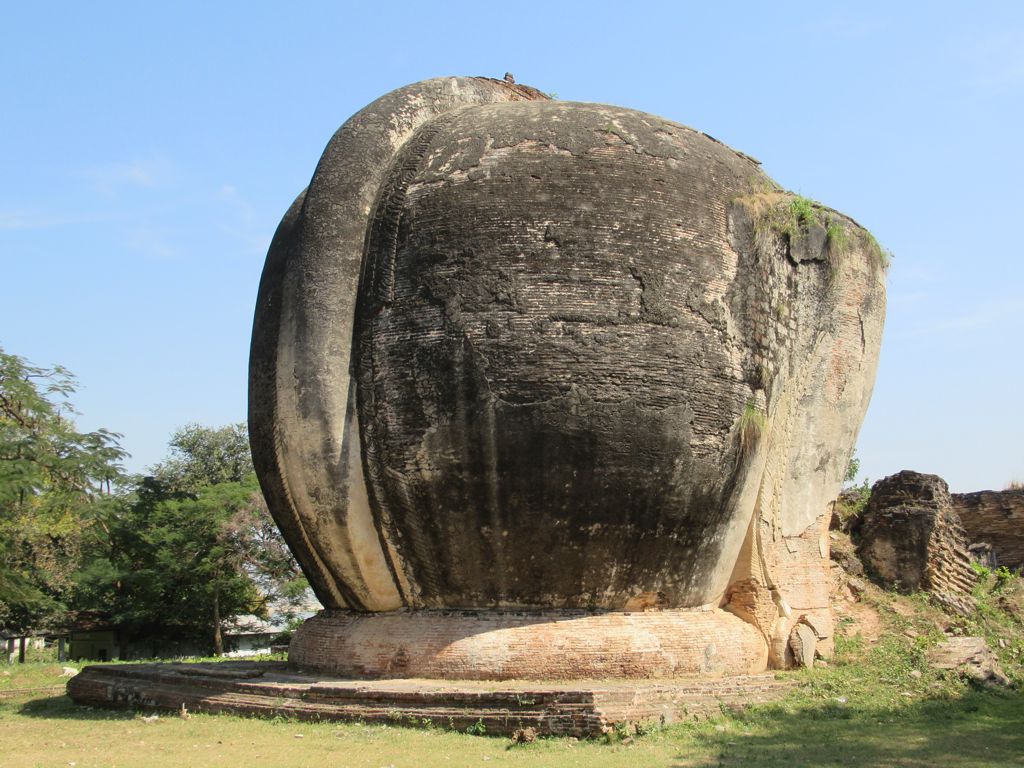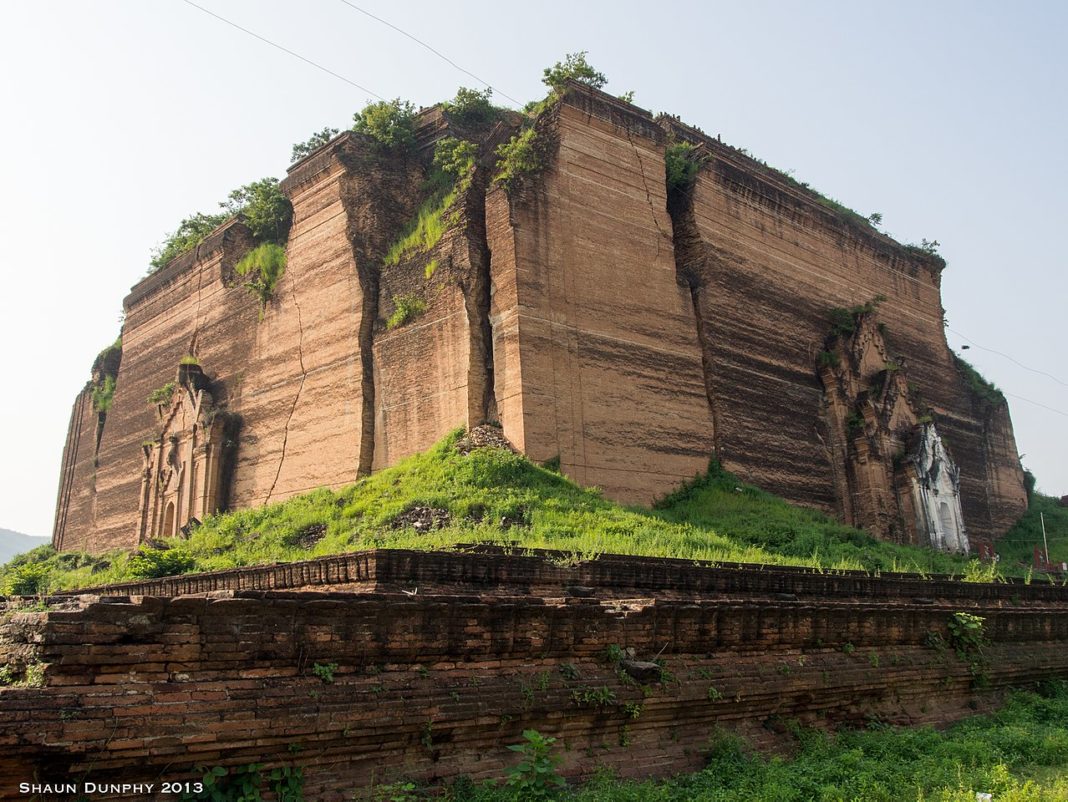The breathtaking temples, country lanes and a delightful boat trip will keep you in another peaceful land of Myanmar. Definitely, it is a perfect destination for those who want to get away from city life.
Hsinbyume Pagoda
The Hsinbyume Pagoda, also known as the Mya Thein Tan Pagoda or “White Pagoda” is one of the most unique and beautiful pagodas in Myanmar, and that’s saying something. It was built in 1816 by King Bagyidaw to commemorate his first consort and his cousin, Princess Hsinbyume who died in a childbirth in a site nearby.
 Different from other pagodas in Myanmar, the pagoda is deeply linked with the legendary Mount Meru, the center of the universe in Buddhist cosmology. Seven wavy terraces representing the seven mountain ranges and oceans around MountMeru lead up to the stupa at the top which represents the Mount Meru itself. All the way along are niches containing small statues of mythological figures such as various nat (spirits), ogres, and naga serpents and the gold spire enshrines aBuddha image. Visitors can climb to the top of the pagoda to enjoy the cravings and the details of the building, get the nice views of the surrounding landscape and take some gorgeous photos. Do not forget to bring sunscreen and sunglass, the sunlight there can be blinding, especially at noon.
Different from other pagodas in Myanmar, the pagoda is deeply linked with the legendary Mount Meru, the center of the universe in Buddhist cosmology. Seven wavy terraces representing the seven mountain ranges and oceans around MountMeru lead up to the stupa at the top which represents the Mount Meru itself. All the way along are niches containing small statues of mythological figures such as various nat (spirits), ogres, and naga serpents and the gold spire enshrines aBuddha image. Visitors can climb to the top of the pagoda to enjoy the cravings and the details of the building, get the nice views of the surrounding landscape and take some gorgeous photos. Do not forget to bring sunscreen and sunglass, the sunlight there can be blinding, especially at noon.
Mingun Pahtodawgyi (Mingun Paya)
The massive, unfinished Mingun Pagoda is an impressive site on the bank of Irrawaddy River. Two giant stone lions about 29 meters high guard the pagoda, which if completed, will be the largest pagoda in Myanmar.
 The history of the pagoda can be dated back to the end of the 19th century when King Bodawpaya wanted to build the largest pagoda in the country to enshrine his war loot, a Buddha tooth relic, something that his predecessors had not achieve. To demonstrate his power, the King intended the pagoda to be 152 meters high and even moved to a new residence on an island in the river to supervise the construction. However, when the pagoda reached a height of 50 meters, the project was halted due to a lack of fund and labor. Till today, the pagoda is still left unfinished. Nevertheless, it still serves as a place of worship and meditation with a Buddha image enshrined in it. To enter the shrine, you need to take off your footwear.
The history of the pagoda can be dated back to the end of the 19th century when King Bodawpaya wanted to build the largest pagoda in the country to enshrine his war loot, a Buddha tooth relic, something that his predecessors had not achieve. To demonstrate his power, the King intended the pagoda to be 152 meters high and even moved to a new residence on an island in the river to supervise the construction. However, when the pagoda reached a height of 50 meters, the project was halted due to a lack of fund and labor. Till today, the pagoda is still left unfinished. Nevertheless, it still serves as a place of worship and meditation with a Buddha image enshrined in it. To enter the shrine, you need to take off your footwear.
Mingun Bell
Weighing 90 tons, the Mingun bell has long been the world’s largest working bell before a 116-ton bell found in China. This enormous bell was cast in 1808 at the order of King Bodawpaya. The weight of the bell is 55,555 viss (a Burmese unit of measurement), and its mnemonic words are inscribed on the surface of the bell. A wooden post is used to strike the bell to ring. To achieve a pleasant ringing tone, an alloy of five metals was used to make the bell including gold, silver, bronze, iron, and lead.
 The Mingun Bell was intended to be installed at the top of the giant Mingun Pagoda but for some reason, sheltered in a nearby Zayat, an intricate Burmese style pavilion with multitier roofs. It was said to be cast on an island in the middle of the Ayeyarwady River, and to transport it to the present site a barge was constructed directly under the bell. In the rainy season, the river water rose and floated the barge. When the floating was carried out, the king himself led the procession across the Ayeyarwady. The Mingun Bell plays a big role in religious affairs. When one does a good deed, Buddhist in the know will strike the bell to call on others to share the merit.
The Mingun Bell was intended to be installed at the top of the giant Mingun Pagoda but for some reason, sheltered in a nearby Zayat, an intricate Burmese style pavilion with multitier roofs. It was said to be cast on an island in the middle of the Ayeyarwady River, and to transport it to the present site a barge was constructed directly under the bell. In the rainy season, the river water rose and floated the barge. When the floating was carried out, the king himself led the procession across the Ayeyarwady. The Mingun Bell plays a big role in religious affairs. When one does a good deed, Buddhist in the know will strike the bell to call on others to share the merit.
Lions Of Stone
Another worthwhile ruin to see on a Mingun day trip is the Chinthe ruins colloquially termed “the Lions of Stone”.
 These huge lion sculptures were originally built to guard the Hsinbyume Pagoda. Due to erosion and earthquake damage, the Lions of Stone are now nearly unrecognizable. However, it’s still possible to make out some fine carved details.
These huge lion sculptures were originally built to guard the Hsinbyume Pagoda. Due to erosion and earthquake damage, the Lions of Stone are now nearly unrecognizable. However, it’s still possible to make out some fine carved details.
According to indochinaodysseytours.com, weseektravel.com














